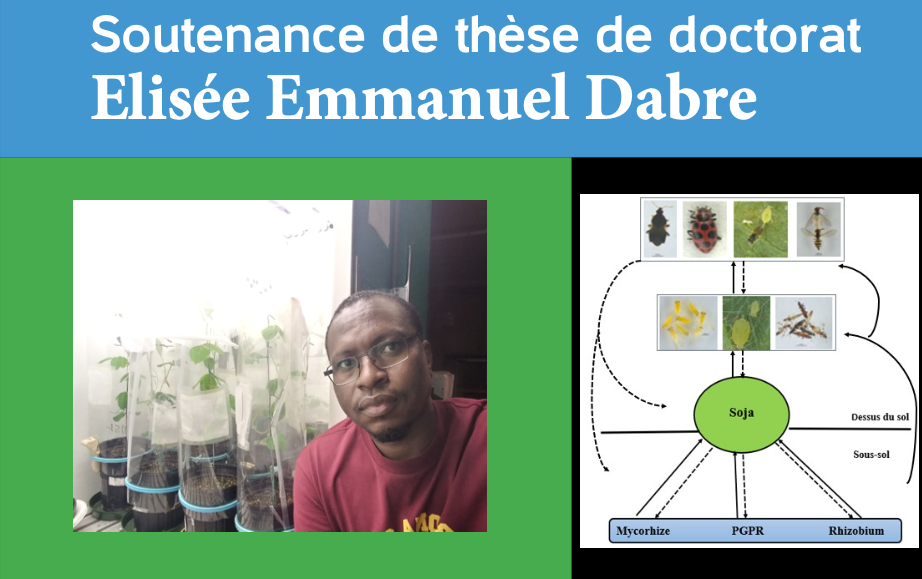Many congratulations to the new PhD! Élisée successfully defended his dissertation 28 March 2022 and has since submitted the final version to the university: The effects of arbuscular mycorrhizal fungal and rhizobacterial inoculants on soybean insects. Soil microorganism inoculants are often used in agriculture to boost the growth and hence the yield of various crops, including soybean. However, it is not clear how these inoculants might affect pest insects feeding on the plants. Perhaps the inoculants, by stimulating plant growth, contribute to providing a larger, healthier meal to herbivorous insects, increasing negative pest effects. Alternatively, if the inoculants increase the health and vigor of the plants, perhaps they help the plants defend themselves against herbivorous insects. Finally, if the herbivorous insects are affected by the presence of soil inoculants, whether positively or negatively, might those effects be transmitted to the next trophic level, that is, to the predators and parasites of the herbivorous insects?

Élisée’s dissertation is composed of three scientific chapters, each examining these issues at different organizational levels: the first and second trophic levels (aphids on soybean); the third trophic level (a predator and a parasitoid of the soybean aphid); the insect community in an agricultural field.
In his first manuscript, he found that, in a laboratory setting, the presence of arbuscular mycorrhizal fungal and rhizobacterial inoculants enhanced both the growth of soybean itself and the population growth of the soybean aphid. There was a synergistic effect where the two inoculants stimulated plant and aphid population growth more than either inoculant alone.
In his second manuscript, Élisée took the same model system and measured the development time and other health parameters of a ladybird beetle predator and a parasitoid wasp feeding on aphids reared on plants growing in inoculated soil. In this experiment, he found that whatever effects inoculation had on soybean aphids were not generally transferred to the next trophic level.
Finally, in his third manuscript, published in PLOS ONE, Élisée looked at the effects on the insect community of the field-inoculation of arbuscular mycorrhizal fungi and rhizobacteria, as well as the effects on the insect community of different levels of mycorrhizal colonization of soybean roots. Just as inoculation stimulated aphid colony growth in his first experiment, Élisée found a greater abundance of piercing-sucking insects (notably the soybean aphid and leafhoppers) in inoculant-treated parcels. However, and contrary to that finding, he found a negative correlation between the rate of mycorrhizal colonization and the abundance and diversity of piercing-sucking and chewing herbivorous insects. This is a very complicated study system: as well as the inoculated microorganisms, the ‘natural’ agricultural environment also has a native flora whose abundance and diversity Élisée was not able to measure.

• Dabré ÉE, Lee Soon-Jae, Hijri M, Favret C. 2021. The effects of mycorrhizal colonization on phytophagous insects and their natural enemies in soybean fields. PLOS ONE 16(9): e0257712. DOI: 10.1371/journal.pone.0257712